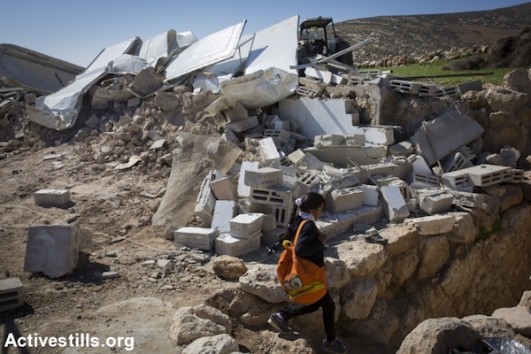Israel ramped up its practice of demolishing Palestinian structures in the West Bank this year, destroying more than twice as many as it did in 2015.

The number of Palestinian structures Israel has destroyed in the West Bank and East Jerusalem has passed the 1,000 mark for the year, according to data from the UN humanitarian agency. As of the end of November, Israeli authorities had demolished 1,051 structures, displacing 1,569 Palestinians.
This represents, with a month of the year left to go, a doubling of the equivalent number from 2015, during which Israel demolished 544 Palestinian structures in the West Bank and East Jerusalem, displacing 757 Palestinians.
Most of the demolitions took place in Area C, which makes up 60 percent of the West Bank and is under full Israeli military security and administrative control. (In November, 25 structures were demolished in Areas A and B, ostensibly under Palestinian administrative control.)
Israel justifies administrative demolitions by arguing that the structures in question have been built without a permit. However, it is almost impossible for Palestinians in Area C to obtain building permits: between 2010 and 2014 the army’s Civil Administration granted just 1.5 percent of requests.
Moreover the IDF admitted earlier this year that when it comes to demolitions in the West Bank, “enforcement against Palestinians is hundreds of percentage points higher [than against Jews].”
Particularly affected — especially by home demolitions, which hit a 10-year high in the first half of 2016 — have been Palestinian communities in the South Hebron Hills, the Jordan Valley and the E1 area around Ma’ale Adumim.
In the South Hebron Hills, the Palestinians living in ‘Firing Zone 918’ — a military training zone unilaterally declared by the Israeli army — are subject to continuous attempts by the army to force them out so their land can be used for military drills. The Jordan Valley is a long-term annexation target of the Israeli government; and Palestinians living in the E1 area around the settlement of Ma’ale Adumim are under ongoing threat of expulsion due to Israel’s plans to create a contiguous territory between Jerusalem and the settlement.

In addition, about 18 percent of the West Bank is declared as a closed military zone reserved for IDF drills, meaning that Palestinians are prohibited from building in these areas. An IDF officer has previously admitted that this is a tactic the Israeli army uses for expelling Palestinians from parts of the West Bank.
In response to a query as to why the rate of demolitions had increased so dramatically this year, Coordination of Government Affairs in the Territories (COGAT) — which oversees Israeli policies in the West Bank and Gaza — told +972 Magazine:
According to the Oslo Accords, which were signed between Israel and the Palestinian Authority, and are recognized by the international community, every construction project in area C requires the approval of the competent authorities. The Civil Administration, pursuant to its authority, takes enforcement steps against illegal construction as part of its function to enforce building laws according to the rulings and verdicts of the court.
We emphasize that the Civil Administration is currently promoting several programs for the benefit of the Palestinian community in Judea and Samaria. Recently two schools have been approved to be built in Area C for the Palestinian community, and a master plan for the Ta’anach village has been approved and the master plan is expected to expand the village significantly.
Israel has issued more than 14,000 demolition orders since 1988; as of the end of 2015, around 3,000 of these had been executed.


